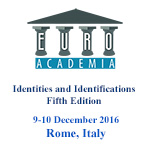Euroacademia Conferences
 Europe Inside-Out: Europe and Europeanness Exposed to Plural Observers (9th Edition) April 24 - 25, 2020
Europe Inside-Out: Europe and Europeanness Exposed to Plural Observers (9th Edition) April 24 - 25, 2020 Identities and Identifications: Politicized Uses of Collective Identities (9th Edition) June 12 - 13, 2020
Identities and Identifications: Politicized Uses of Collective Identities (9th Edition) June 12 - 13, 2020 8th Forum of Critical Studies: Asking Big Questions Again January 24 - 25, 2020
8th Forum of Critical Studies: Asking Big Questions Again January 24 - 25, 2020 Re-Inventing Eastern Europe (7th Edition) December 13 - 14, 2019
Re-Inventing Eastern Europe (7th Edition) December 13 - 14, 2019 The European Union and the Politicization of Europe (8th Edition) October 25 - 26, 2019
The European Union and the Politicization of Europe (8th Edition) October 25 - 26, 2019 Identities and Identifications: Politicized Uses of Collective Identities (8th Edition) June 28 - 29, 2019
Identities and Identifications: Politicized Uses of Collective Identities (8th Edition) June 28 - 29, 2019 The European Union and the Politicization of Europe (7th Edition) January 25 - 26, 2019
The European Union and the Politicization of Europe (7th Edition) January 25 - 26, 2019 7th Forum of Critical Studies: Asking Big Questions Again November 23 - 24, 2018
7th Forum of Critical Studies: Asking Big Questions Again November 23 - 24, 2018 Europe Inside-Out: Europe and Europeanness Exposed to Plural Observers (8th Edition) September 28 - 30, 2018
Europe Inside-Out: Europe and Europeanness Exposed to Plural Observers (8th Edition) September 28 - 30, 2018 Identities and Identifications: Politicized Uses of Collective Identities (7th Edition) June 14 - 15, 2018
Identities and Identifications: Politicized Uses of Collective Identities (7th Edition) June 14 - 15, 2018
Once Upon a Time in Russia. Depictions of a Nation through Fairy Tales in the Russian Painting of the 19th Century
-
-

-
Presentation speakers
- Ludmila Piters-Hofmann, Humboldt University of Berlin, Germany
- Download presentation
Abstract:
The exigency of a specified national identity was a Pan-European phenomenon in the 19th century and especially distinct in Russia, due to its ambiguous position between the ideas of Slavophilia and Westernism. At the same time fairy tales and folktales became the subject of fine arts in different cultural areas. Their depiction on large-sized canvases can be seen as a result of their contemporary reception as genuine national heritage. The concomitant ennoblement of the subject ‘fairy tale’? in the arts shows its utilization for the construction of national identity, alongside with monumental historical or socio-critical painting. Folktales served as subjects for the more private and personal interpretation and demonstrated not only the artistic construction of national characters, but also the representation of the county itself. The specific elements for the symbolization of Russia in fairy tale painting will be in the focus of this paper. The two versions of the ‘Three Tsarevnas of the Underground Kingdom’ by Viktor Vasnetsov (1848-1912) act as a good example for the embodiment of Russia by using a fairy tale. The first version was painted by Vasnetsov on behalf of the patron of the arts Savva Mamontov (1841-1918), who commissioned three paintings for the main office of his Donetsk Railway Company. The second version was acquired by the collector Ivan N. Tereshchenko (1854-1903). Both versions show the three tsarevnas of the fairy tale about ‘The Three Underground Kingdoms’. By adapting to the first painting’s destination Vasnetsov converted the kingdoms of the fairy tale to represent the richness of natural resources of the Donetsk area and kept this modification in his second version. Thereby he decided to focus on the depiction of the county itself and only utilized the fairy tale as a means for this purpose.
-
Related Presentations

Treatment of Minorities in the Media - Visualizing the Other
- Emmanuelle Bruneel













